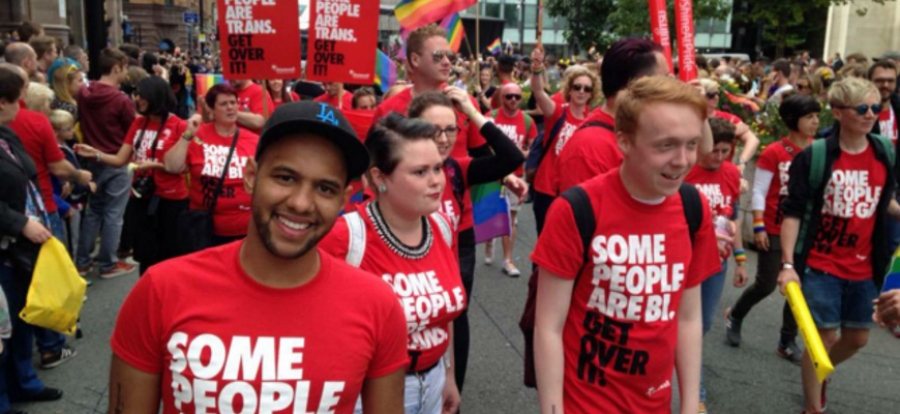L = Lesbian: individuals who identify as female and who have a sexual interest in women.
G = Gay: individuals who identify as having a sexual interest in those of the same sex as them.
B = Bisexual: individuals who express a sexual interest in those of either sex.
T = Transgender: individuals who feel they were born into the wrong physical body. This letter can include those who have sought medical treatment as well as those who do not wish to do so.
P = Pansexual: individuals who do not feel their sexual attraction is limited by biological or assumed sex, gender identity or gender.
A = Asexual: I have met many individuals who have identified as asexual and their opinions and definitions are varied, but broadly identifying that they do not feel sexual attraction or feelings and/or they do not wish to have a sexual/physical relationship with anyone. However, some said they did not rule out a platonic, but close, friendship.
Q = Questioning (alternatively, Queer): whether that is questioning their sexuality or gender identity, or indeed both.
The impact on young people:
When working with young people over the years, many have reported feeling that there are some people who do not take them seriously, calling it merely a phase. Others have experienced more open hostility towards their sexual orientation or identity. This is supported by Stonewall, who have produced a number of very thorough surveys and studies. Whether you are a teacher, parent or someone who has any form of contact with young people, I would recommend reading the Teachers' Report 2014.
The report identifies some saddening and frightening statistics. For instance, nearly 9 in 10 Secondary school teachers said that pupils in their school had experienced "The ‘Some people are gay. Get over it!' stickers and posters are very effective."homophobic bullying. One of the most common expressions being “that's so gay”, there are those who will seek to defend this phrase as being simply part of the English language or an expression that does not relate to sexuality. I disagree: the word “gay” is being used here to describe something that the speaker thinks is rubbish or inferior. As the common and accepted definition of the word gay relates to someone who expresses a sexual preference for those of the same sex as them, the speaker is equating the sexual preference with being inferior or rubbish. This is clearly not acceptable, and once you start listening out for it you suddenly realise how commonly it is used in society (and not just in schools; alongside such restrictive and gender-stereotypical expressions as “like a girl”, “you're such a girl” or “man up”), that is not to say that it is in anyway acceptable. The first step here is to begin to challenge, educate and change the way students see and use this word.
Challenging abuse:
One way to challenge and educate at the same time, the use of this word, is through some of the resources provided by Stonewall. As a teacher who coordinates and oversees the provision of PCSHE, one of the things I was keen to do was to create an environment where students felt supported and able to access information without feeling they were identifying that they wanted to, until/if they were ever ready to do so.
I have found the Stonewall 'Some people are gay. Get over it!' stickers and posters to be very effective. Almost 1 in 4 teachers say their school makes use of these as posters. They can be placed around school, and staff can be given them for their laptops / workspaces if they want them. This makes it clear to students that homophobic language will not be tolerated and will be challenged. The poster; 'That's so gay. Let's be honest it's probably not!' is also another very effective resource with a very powerful impact among students. I have found that this has led to students challenging others when they say “that's so gay” and pointing to the poster!
PCSHE (Personal, Citizenship, Social and Health Education)
PCSHE can act as a means of providing education and support for students.
As I mentioned earlier, as coordinator of PCSHE I was keen to review the schemes of learning for our students to ensure that all students were being included. I am proud to say that I feel we have a very inclusive scheme and that we were teaching issues like consent and healthy relationships long before they became the political and governmental focus.
It is essential that sexual education does not just focus on health and issues within heterosexual relationships, as this can be isolating and distressing for students that do not identify as such. This can lead to heteronormative assumptions being made about sex, health and relationships. As such, strong schemes of learning should include information about same sex relationships, asexual views and information about transgender relationships and, importantly, experiences.
Students should also be provided with information about where they can find support and further information. While the internet is a wonderful tool if you know where to look, we need to ensure students are not being misinformed or scared when they have questions. Something that can also be effective is providing a PCSHE display that provides sources of support, information and makes it clear that relationships and families can take a range of forms and structures, and that the concept of a 'normal' family does not simply mean a heterosexual nuclear family.
What about the teachers?
This is something we must neither ignore nor forget. Teachers are an important part of any equality policy, but at the same time they may also have experienced homophobic comments, whether made by students or staff members. We also need to consider that some schools may not feel comfortable teaching about lesbian, gay or bisexual relationships or issues. Faith schools, for example, were found to be less likely report their school allowing them to teach LGBTPAQ issues.
Teachers should strive for fairness and impartiality in their work, we accept this as a key part of their professionalism and skill. However, as teachers make up a hugely varied group it is perhaps not surprising that there are teachers who do not necessarily see the value in teaching LGBTPAQ issues explicitly.
One comment (page 17) highlighted in the report suggested there were more important issues for teachers to be dealing with and that this was merely the latest issue to have been "Our students have the right to come to school and be treated as individuals with rights and respect."jumped upon by the 'gay rights mafia'. Our students have the right to come to school and be treated as individuals with rights and respect. This is the best way to foster a mutually respectful relationship and environment. If staff do not see the value in teaching LGBTPAQ issues and topics, that is a separate issue to not feeling comfortable or confident. With a teacher who feels they have not had the training and is worried about doing a good job and supporting the student there are lots of resources and potential training options that can be provided. Indeed, within their school they may have a Stonewall champion, within their county they may have training available, and at a national level Stonewall run training for teachers as well as providing online resources.
A teacher who does not see the need or value in addressing LGBTPAQ issues / topics is a very different area for schools to both be aware of and to respond to. As teachers, we must always ensure that we remain impartial, we do not share religious or political views and that we make our classrooms supportive, safe spaces for all of our students. This means we must challenge homophobic language in the same way we would challenge any discriminatory language or behaviour, and to do so is not an affront to free speech as was suggested by one respondent in the survey.
As a historian and Politics teacher, I dislike the abuse of the phrase 'free speech'. We teach students that free speech exists up to the point at which their freedom of speech would begin to take away the freedom of others. This includes racism, hate speech and homophobic language. This, I feel, is an indisputable fact that exists in the UK under the Human Rights Act.
As professionals, it is our job to model acceptable language and societal interactions; to allow a student to use language which would harm another is something that we cannot allow within the classroom. I would like to stress that there were many, far more, comments in the report that made it clear that many teachers felt homophobic behaviour should be challenged. Indeed, some comments made it clear that staff recognised and challenged those who did not 'see' or acknowledge homophobic bullying existed (on page 18, Ruth's comment makes this clear and also links to the further issue of gender stereotyping. This can be damaging not only to students who are questioning their sex or gender but to those who feel the stereotypes hold them back or prevent certain options being available).
Where next?
This is not something that will be easily solved, but it is something that we can continue to chip away, bit-by-bit eroding the use of homophobic language. We can ensure an environment where all students feel safe and supported.
How do you teach LGBTPAQ matters in your school? Let us know below.


















